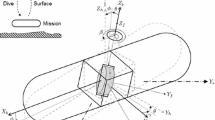Abstract
Valuable mineral resources are widely distributed throughout the seabed. autonomous underwater vehicles (AUVs) are preferable to remotely-operated vehicles (ROVs) when probing for such mineral resources as the extensive exploration area makes it difficult to maintain contact with operators. AUVs depend on batteries, so their power consumption should be reduced to extend exploration time. Power for conventional marine instrument systems is incorporated in their waterproof sealing. External intermittent control of this power source until termination of exploration is challenging due to limitations imposed by the underwater environment. Thus, the AUV must have a power control system that can improve performance and maximize use of battery capacity. The authors developed such a power control system with a three-step algorithm. It automatically detects underwater operational states and can limit power, effectively decreasing power consumption by about 15%.
Similar content being viewed by others
References
GERMAN C R, YOERGER D R, JAKUBA M, et al. Hydrothermal exploration with the autonomous benthic explorer[J]. Elsevier Deep-sea Research Part I, 2008, 55: 203–219.
CONTE G, SERRANI A. Robust control of a remotely operated underwater vehicle[J]. Elsevier Automatica, 1998, 34(2): 193–198.
HAGEN Per Espen, Størkersen Nils, MARTHINSEN BjØrn-Erik, et al. Rapid environmental assessment with autonomous underwater vehicles[J]. Journal of Marine Systems, 2008, 69: 137–145.
HASVOLD Øistein, JOHANSEN K H, VESTGAARD K. The alkaline aluminum/hydrogen peroxide power source in the Hugin II unmanned underwater vehicle[J]. Journal of Power Sources, 1999, 80: 254–260.
SAWA Takao, AOKI Taro, YAMAMOTO Ikuo, et al. Performance of the fuel cell underwater vehicle URASHIMA[J]. Acoust Sci & Tech, 2005, 26(3): 249–257.
NAM Heungwoo, AN Sunshin. An ultrasonic sensor based low-power acoustic modem for underwater communication in underwater wireless sensor networks[J]. EUC Workshops, 2007, LNCS 4809: 494–504.
HAN Jun. Noncontact power supply for seafloor geodetic observing robot system[J]. J Mar Sci Tech, 2007, 12(3): 183–189.
Acoustic **er and Data Storage Transmitter in one, www.sonotronics.com, (AST-03).
Author information
Authors and Affiliations
Corresponding author
Additional information
Young Jim KIM was born in 1964 and received his PhD in electronic and computer Eng., from Dankook University in 2006. He is currently working for the Korea Institute of Industrial Technology (KITECH), Cheonan, Korea. His research interests include control systems of marine equipment, application of ultrasonic sensors, and motor control.
Hyung Tae KIM received the PhD degree in precision mechanical engineering from Hanyang University, Seoul, Korea, in 2005. He is currently a researcher at the Manufacturing System Division, KITECH. He has published 15 papers in international journals and conferences. His research interests include automatic control in semiconductor manufacturing, vision-motion systems, and industrial programs. He reviews papers in SCI journals and IEEE conferences.
Young June CHO received his B.S. degree in mechanical Eng., from Hanyang University in 1979, and his M.S. and PhD degrees in mechanical eng., from Korea Advanced Institute of Science and Technology (KAIST) in 1981 and 1986, respectively. He is currently working for KITECH. His research interests include automation control, application of optical parts, and marine equipment.
Kang Won LEE received the PhD degree in precision mechanical engineering from Hanyang University, Seoul, Korea, in 1998. He is currently the manager of the Technical Service Division, KITECH. He has conducted more than 100 research projects and developed semiconductor manufacturing machines. His research interests include semiconductor manufacturing using lasers, ultrasonics, and magnetics.
Rights and permissions
About this article
Cite this article
Kim, Y.J., Kim, H.T., Cho, Y.J. et al. Development of a power control system for AUVs probing for underwater mineral resources. J. Marine. Sci. Appl. 8, 259–266 (2009). https://doi.org/10.1007/s11804-009-8077-1
Received:
Published:
Issue Date:
DOI: https://doi.org/10.1007/s11804-009-8077-1




